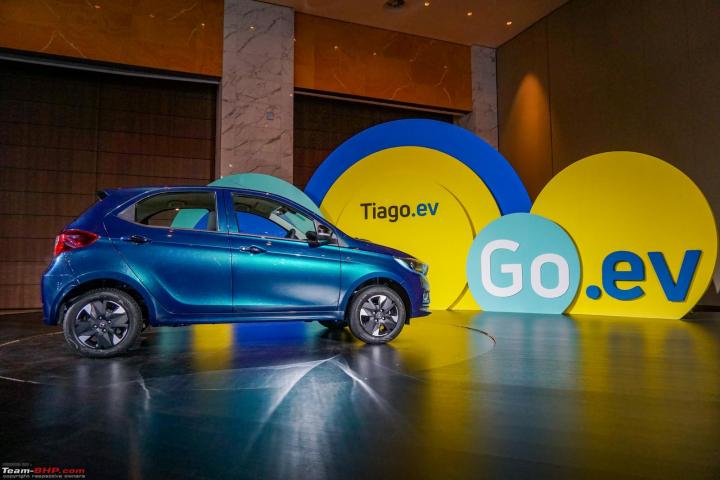News
Tata Tiago Electric: Our observations after a day of driving
If you’re wondering, how it compares to the Tigor EV with the torque deficit, don’t worry. The Tiago EV feels very similar to drive due to the lower kerb weight (86 kg lighter) and the tuning of the motor.
Driving the Tata Tiago EV
The car that we got to drive was the long-range variant with the 24kWh battery pack. It has a Permanent Magnet Synchronous Motor that puts out 74 BHP & 114 Nm of torque:
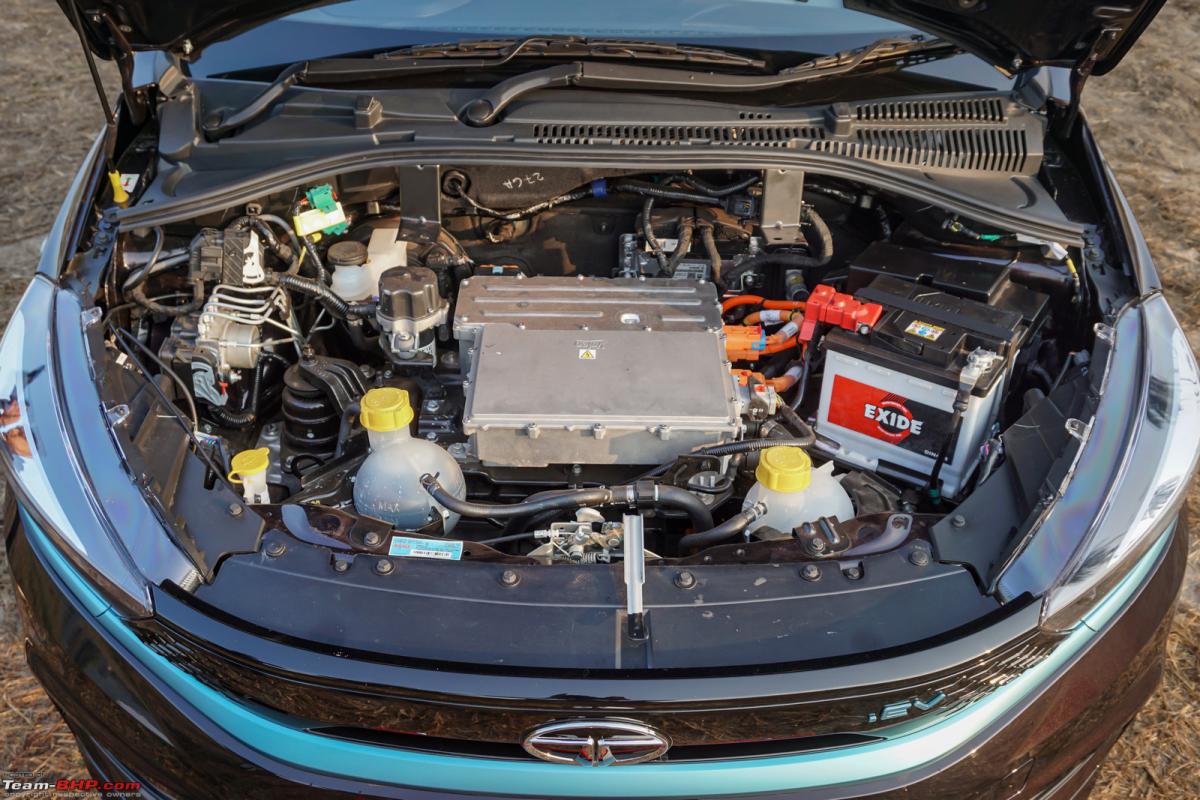
Before we get to the driving part, let’s get some basics right. There are 3 main components in an EV – the battery, the motor, and the controller/charger. The battery is what stores the energy and the motor is what uses that energy to move the car. The controller/charger converts the energy from the battery into a usable form to power the motor. In more technical terms, the power grid from your house or a charging station is usually an AC current. The lithium-ion battery can store electric energy in DC form. So while charging, there’s an AC/DC converter that will convert the power grid's AC into DC and store it in your car’s battery. The DC fast chargers that you see usually have the AC/DC converter inbuilt, which is how they can charge your car’s battery faster. The controller typically sits on top of the motor. In the case of the Tiago EV, the controller and motor are placed under the bonnet.
The Tiago EV shares its powertrain with the Tigor EV. However, there are a few differences. The torque rating is down by 56 Nm in the Tiago EV. Both have a claimed 0-60 km/h time of 5.7 seconds, despite the Tigor EV being heavier. The tuning is different on both cars and it’s worth noting that the maximum motor rpm of the Tiago EV is higher than that of the Tigor EV. Now, let’s get to the driving part. People driving an EV for the first time will need to get used to the eerie silence after pressing the start/stop button, but it takes just a couple of drives to feel comfortable with it. There are 4 transmission modes to choose from – D, R, N, and S. ‘D’ mode is more designed for city driving conditions, while ‘S’ mode is when you want that extra power (at the cost of FE, which in this case, is the battery charge level). The rotary dial for transmission modes is not very intuitive and a traditional AT gear lever with slots would’ve been preferred. Tata has integrated their recent electric cars with a useful feature to go with this rotary transmission dial. Say you’re at a traffic signal, you no longer have to switch to ‘N’ and pull the handbrake. You can just pull the handbrake in ‘D’ mode and the creep function is disengaged, so the car won’t move. Neat integration, but the customers will have to be educated about this.
As a safety feature, the car will always start in "N" mode. Engage D, take your foot off the brake pedal and the Tiago EV gets off the line in a perfectly smooth manner, crawling at 6 km/h. It’s very linear and without any jerks. Driving around in "D" mode within the city is a super convenient affair. No clutch, no gears, no turbo lag & no noise means even a newbie driver will seem like a smooth one. The motor has sufficient torque, but it is used conservatively in "D" mode for a smoother driving experience & to maximize driving range. Think of "D" being more like "ECO" mode. Performance in D mode is decent, but that's it. You won’t have any issues keeping up with city traffic & power is sufficient for day-to-day commuting. When you want to suddenly accelerate from say 40 - 50 km/h though, you will feel the power deficit & it feels like a 1.2L NA petrol! If you want quicker acceleration, simply switch to "S" mode and you’ll notice a BIG difference in the way the power is put down. The throttle response is much sharper and you get a stronger surge of power. Added bonus = in "S", you'll see the power gauge on the left showing a redline at the limit (via 3 red bars), just like a conventional rev counter.
Out on the open road, D mode is adequate for regular drivers. You can cruise comfortably on the expressway. However, if you need to execute an overtaking manoeuvre quickly, S mode comes in handy. You'll also find yourself engaging "S" mode whenever you are in the mood for some fun. The Tiago EV feels peppy in Sport mode, even on the open road. Power is delivered strongly till 100 km/h, after which it starts to taper off. The Tiago EV's top speed is limited to ~120 km/h and progress from 110 - 120 km/h is quite slow. Must add that electric cars aren't good at high-speed cruising, from the range point of view. Drive continuously at 110 - 120 km/h in "S" mode and you'll see the battery level drop alarmingly fast. That's one of the reasons you'll see most EVs driving at 80 - 90 km/h on the expressway in the middle lane. If you’re wondering, how it compares to the Tigor EV with the torque deficit, don’t worry. The Tiago EV feels very similar to drive due to the lower kerb weight (86 kg lighter) and the tuning of the motor. All in all, it is a smooth car to drive in the city and on the occasional inter-city highway trips at 80-100 km/h.
Regenerative Braking
Remember when we said Tata is updating its cars based on customer feedback? Here’s an example. The Tigor EV that we drove last year didn’t have adjustable regenerative braking. The Tiago EV gets this feature and the latest Tigor EV also has been updated with the addition of adjustable regenerative braking. Way to be proactive Tata Motors! There are 3 levels of regeneration that you can choose from. You can also turn it off completely and depend on the brakes for stopping the car. Driving with maximum level 3 regeneration, you can feel your head nod when you lift off the accelerator. It’s good for maximizing range, but not so good for smooth driving. You can switch to level 1 or 2 for smooth deceleration on lift-off. One-pedal driving is very much possible in the city with level 3 regen as the deceleration is quite strong. However, the car won't come to a complete halt. It will crawl forward and you have to apply the brakes to stop it. This is again an individual preference and we were told that depending on customer feedback, Tata will or will not make the change in the next update. This change will merely be a software update, so it can be incorporated easily.
A thoughtful integration is that in level 3 regeneration and sometimes in level 2 (if the deceleration is strong), the brake lamps light up to let the car behind know that the Tiago EV is slowing down. Another point to note is that the level 3 regeneration will not be as strong when the battery percentage is 85 and above. It’ll show that the car is on level 3, but it won’t decelerate as strongly.
Noise, Vibration & Harshness (NVH)
Well, there’s no engine noise for starters! The only sound coming is a faint whirring by the electric motor. No gearshifts & minimal mechanical parts mean no jerks or vibrations. On the highway, tyre noise starts creeping into the cabin early at 80 km/h. You'll hear it more because there is no engine sound to drown some of it out.
Range
Range anxiety is a big concern with EVs. However, it’s only when you are pushing the car hard that you'll notice the range and battery percentage falling at a rapid pace. Tata Motors claims that under standard test conditions the Tiago EV has a range of 315 km, but under normal driving conditions, you can expect a range of ~200 km. This is enough for those intending to drive primarily in the city.
The range displayed on the MID varies based on the driving style of the previous driver. So, we couldn’t depend on the range readout on our test drive. There’s another useful bit of information on the MID next to the speedometer marked as ‘AEC’ which stands for average energy consumption and has a Wh/km reading. We managed to get around 140 Wh/km with ~60% driving in S mode and 40% sedate driving with maximum regeneration. If you want to calculate what that translates to in range, just divide 24,000 (24 kWh battery capacity) by the AEC reading. In this case, we got ~171 km of range, which is not bad considering the amount of time we spent in S mode. Keep the AEC number close to 120 Wh/km and that should translate to ~200 km of range which seems doable.
Charging
Tata Motors has been working with its sister company, Tata Power, to improve the charging infrastructure levels. Also, there are multiple independent players popping up with charging stations everywhere. That said, we can tell you that the best place to charge your EV is at home. Cheapest + most convenient. At an average cost of Rs. 8 per unit, you’ll be paying Rs. 192 for a full tank at home. The estimated charging time (10% to 100%) from a 15A plug is around 8.7 hours. You can opt for the 7.2kW AC charger at your home or office for Rs 50,000 to bring down the charging time to 3.6 hours. A DC fast charger would top up the charge from 10% to 80% in just under an hour.
Suspension
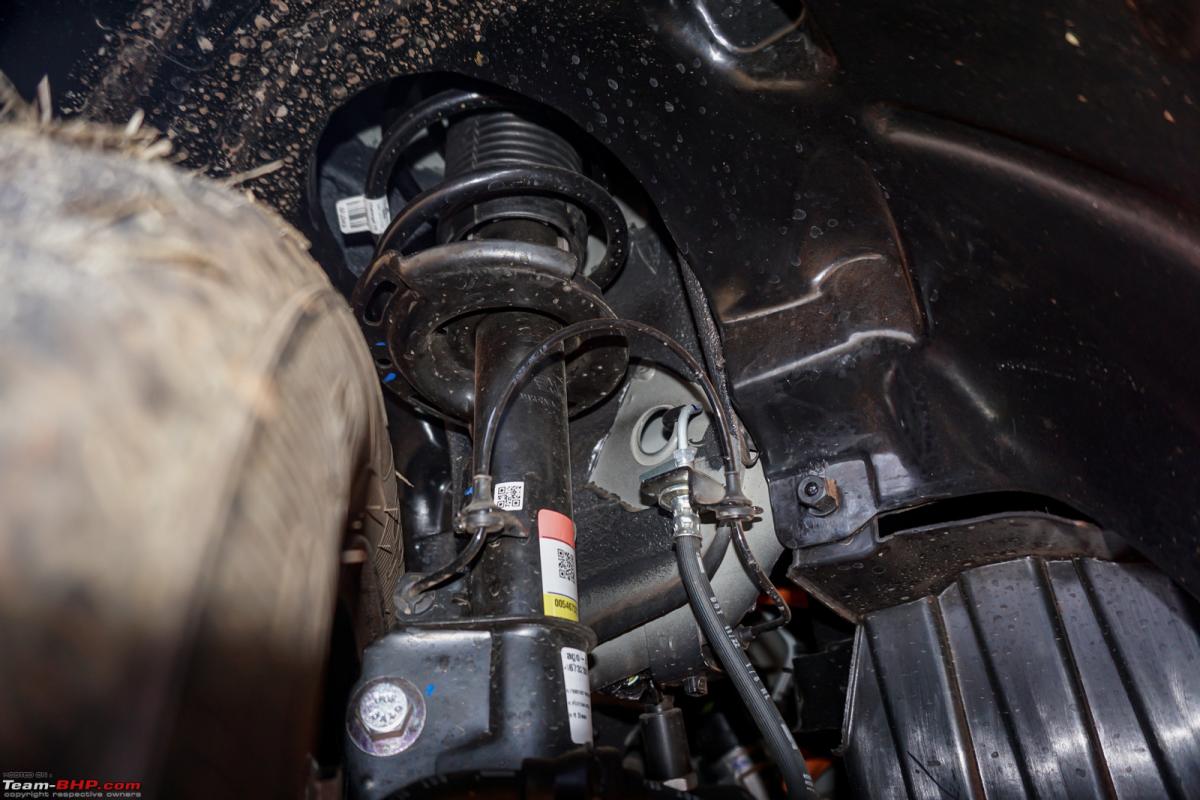
Ride Comfort
The Tiago EV gets a MacPherson strut suspension with dual-path struts at the front and a twist-beam suspension at the rear. It rides on 14-inch rims shod with 175/65 section tyres. The recommended tyre pressure rating is 33 PSI all around.
Like most fossil fuel cars converted to electric, the Tiago EV's suspension has been stiffened up due to the heavy battery pack it is carrying. You'll notice the firmer suspension as soon as you start driving the car. Over some mildly uneven roads in the city at slow speeds, there is a fair bit of movement in the cabin and it even feels jiggly at times. However, the suspension is quite absorbent at low speeds and you can carry some speed over rough roads. You feel more of the road in the Tiago EV, but still, the ride quality is liveable & compliant enough on most city roads. It's only the really big bumps that come in strong, as do the sharp road dips. On the other hand, the Tiago EV rides rather flat on the expressway. At high speeds, i.e. 100 km/h, you have to be careful of the road undulations and expansion joints.
Handling & Dynamics
There are a couple of things that aid the handling characteristics of the Tiago EV. Firstly, it’s the firmer suspension, and secondly, the heavy mechanicals (battery pack + motor) that lower the center of gravity. High-speed stability is very good and you’ll be doing 110 - 120 km/h on the expressway without feeling nervous at all.
Get on some twisty roads and you’ll appreciate the stiffer suspension. The car feels agile and you can carry good speed into corners. The suspension setup does complement the chassis well and the Tiago EV holds its line nicely. Changing direction on back-to-back corners is no problem either. You will like how the EV feels well-balanced in corners. In comparison to the Tigor EV, you don’t have the additional weight on the rear axle which is why it feels a tad bit more composed. Earlier, I had apprehensions that the heavy battery pack might cause some imbalance, but we didn't face any problem on our (admittedly) limited test drive. The only issue is the 175/65 section rubber, which is meant for maximizing range and not for pushing hard into corners. You will hear the tyres chirp when powering out of tight corners.
Steering
The electric power-assisted steering is a nice unit and is super light at parking speeds. The turning radius of 5.1 m is user-friendly and you can manoeuvre the car easily with gentle inputs on the steering. It weighs up adequately as you gain speed. It also has that typical trait in Tata’s steering where the weight is not added gradually. At ~50 km/h, you will notice that the steering wheel suddenly gets heavy. Very weird! The EPS is dead and there’s not much feel or feedback from it.
Braking
The Tiago EV gets disc brakes at the front and drum brakes at the rear. Their performance, in general, is satisfactory. However, we feel that wider tyres would definitely improve the braking performance of the car. Another sore point is that, like most EVs, the brake pedal has a spongy & rubbery feel. It feels weird at first, but you will get used to it.
Continue reading the discussion on the 2022 Tata Tiago Electric on our forum.
News
2022 Tata Tiago Electric Review : 11 Pros & 11 Cons
There are a couple of things that aid the handling characteristics of the Tiago EV. Firstly, it’s the firmer suspension, and secondly, the heavy mechanicals (battery pack + motor) that lower the center of gravity.
Tata Tiago EV Pros
- A well-rounded EV package at a sub-10 lakh rupee starting price. Total value-for-money
- Zero tailpipe emissions & green image will appeal to the environmentally-conscious
- Real-world range of ~200 km is adequate for city commutes & urban dwellers
- Stupendously cheap fuel cost of 1 rupee / km (if you charge at home)
- Peppy behaviour in "S" mode! "D" mode is rather tame though
- Selectable regenerative braking is a very welcome feature
- Sorted road manners due to the lower center of gravity & firmer suspension
- Smooth drive, no gears, light controls & compact size make it an ideal city car
- Well-designed interiors are likeable & user-friendly
- Features like the 8-speaker Harman audio system, cruise control, auto headlamps & wipers, connected car tech & more
- Solid build & construction. Tigor EV's 4-star GNCAP result is reassuring
Tata Tiago EV Cons
- A stiff 4-lakh rupees more expensive than the Tiago Petrol AMT. You're paying for the tech & being an early adopter
- Needs a charging point installed at your home parking. This is not doable for many people
- ~200 km range means this is strictly a city car. No long highway runs
- Stiffer suspension than the regular Tiago means you feel more of the road. Bad roads are felt
- Power tapers off after 100 km/h; top speed of just 120 km/h
- No spare tyre, you will have to make do with a puncture repair kit. We suggest buying a spare
- Long “full tank” charging times in comparison with an ICE car. Overnight charging is best
- Some misses such as "P" mode on the shifter, alloy wheels, adjustable rear headrests, etc.
- Rear headroom is tight. Also, a rare Tata car that cannot seat 5 (best for 4 adults)
- Tata's after-sales service quality is a hit or miss. Remains a gamble
- It's a brand-new technology, so there will be issues & niggles
Read Team-BHP's Detailed Tata Tiago Electric Review.
News
Rumour: Tata Nano could return in an electric avatar
Tata could upgrade the Nano’s existing platform to support its electric powertrain.
According to media reports, there are rumours suggesting that Tata Motors could be planning to bring back the Nano in an electric avatar.
As per the rumour mill, Tata could upgrade the Nano’s existing platform to support its electric powertrain. It is said that major changes could be made to the car’s suspension and tyres.
Reports also suggest that if the plans to put the Nano EV into production reach fruition, Tata could restart its talks with the Tamil Nadu government regarding the acquisition of Ford’s Maraimalainagar plant.
Tata Motors plans to roll out 10 new models in the next 5 years. The carmaker showcased the Curvv and Avinya concepts earlier this year and also launched its most affordable EV offering, the Tiago EV.
Source: TOI
News
Over 20,000 Tata Tiago EVs booked in 1 month
Deliveries of the Tiago EV will commence in January 2023.
Tata Motors launched the Tiago EV in India on September 30, 2022. Now, in just a month since bookings opened, the carmaker has received over 20,000 orders.
The Tiago EV is the most affordable all-electric model in the brand’s line-up, starting at Rs 8.49 lakh (ex-showroom). The first 10,000 cars were booked in just a single day and therefore, Tata decided to extend the introductory pricing for the next batch of 10,000 cars as well.
The Tiago EV uses Tata’s Ziptron high-voltage architecture featuring a permanent magnet synchronous electric motor. Tata claims the car can reach 0-60 km/h in 5.7 seconds.
The Tiago EV comes with two battery options - a 19.2 kWh battery pack offering a maximum range of 250 km and a 24 kWh battery offering 315 km (MIDC) on a single charge. Lower variants come with a 3.3 kW AC charger, while a 7.2 kW AC charger is available on the top-spec XZ+ Tech LUX trim.
The Tiago EV is also compatible with fast charging. The battery can be charged from 10-80% in 57 minutes using a DC fast charger.
Deliveries of the Tiago EV will commence in January 2023.
News
Tata Tiago EV media drives to be held next month
The Tiago EV range starts at Rs 8.49 lakh and is said to offer a range of 250 - 315 km.
We got our first chance to take a close look at the new Tata Tiago EV in September this year. Stay tuned because Team-BHP will review the most affordable electric car from Tata Motors next month.
The Tiago EV range starts at Rs 8.49 lakh and is said to offer a range of 250 - 315 km. This has created a lot of interest in the car.
The Tiago EV is based on Tata’s Ziptron high-voltage architecture, much like the Tigor EV and Nexon EV. It uses a permanent magnet synchronous electric motor and comes with a choice of two battery packs: 19.2 kWh and 24 kWh. They can be charged from 10 - 80% in 57 minutes using a DC fast charger.
The Tiago EV is decently equipped too. The car comes with automatic projector headlamps, automatic climate control, cruise control, rain-sensing wipers, rear parking camera, multi-mode regen and ZConnect connected car features.
News
Tata Motors EV production crosses the 50,000 unit mark
The 50,000th EV rolled out of Tata’s assembly plant in Pune.
Tata Motors has achieved a new production milestone as its EV production crossed the 50,000 unit mark.
The 50,000th EV rolled out of Tata’s assembly plant in Pune. To celebrate the milestone, the company hosted one of the largest customer drives across Delhi, Mumbai, Pune and Bangalore.
Following the success of the Nexon EV, Tata Motors introduced the Nexon EV Max with a larger battery pack. More recently, the carmaker launched the Tiago EV, making it the brand’s first sub-Rs 10 lakh all-electric model. Going forward, Tata is focusing on a three-phased architecture approach for EVs and plans to launch 10 models in the next 5 years.
Tata Motors now offers its EV range in 80 new cities and is expanding its network to more than 165 cities across India.
News
Over 10,000 Tata Tiago EVs booked in a single day
The introductory pricing has been extended for an additional 10,000 customers.
Tata Motors opened the order books for the Tiago EV on October 10. The company now claims to have received over 10,000 bookings for the electric hatchback in a single day.
The Tiago EV was launched at an introductory price of Rs. 8.49 lakh (ex-showroom). The carmaker has now decided to extend the introductory pricing for an additional 10,000 customers.
The Tiago EV is available in four variants: XE, XT, XZ+ and XZ+ Tech LUX. The car comes with two battery options - a 19.2 kWh battery pack offering a maximum range of 250 km and a 24 kWh battery offering 315 km (MIDC) on a single charge.
As per the company, production of the 24 kWh variants has been prioritized. Deliveries will commence in January 2023.
News
Tata Tiago EV bookings open in India
The introductory prices will be applicable for the first 10,000 bookings only.
Tata Motors has opened the order books for the Tiago EV. Customers can book the car by paying a token amount of Rs 21,000.
The Tiago EV is available in four variants: XE, XT, XZ+ and XZ+ Tech LUX, with prices starting at Rs. 8.49 lakh (ex-showroom). The introductory prices will be applicable for the first 10,000 bookings only.
The Tiago EV is offered with two battery options - a 19.2 kWh battery pack offering a maximum range of 250 km and a 24 kWh battery offering 315 km (MIDC) on a single charge.
Test drives will be available from late December and deliveries will commence in January 2023. According to Tata, production of the 24 kWh variants has been prioritized.
News
Tata Tiago EV bookings open on October 10, 2022
Test drives will be available from later December and deliveries will commence in January 2023.
Tata Motors has announced that the bookings for the Tiago EV will open on October 10, 2022. Customers can book the car by paying a token amount of Rs 21,000 at any Tata Motors dealership or online.
The Tiago EV will be on display across leading malls in major cities this month. Test drives will be available from later December and deliveries will commence in January 2023.
The Tiago EV is available in four variants: XE, XT, XZ+ and XZ+ Tech LUX, with prices starting at Rs 8.49 lakh (ex-showroom). The electric hatchback comes with two battery options - a 19.2 kWh battery pack offering a maximum range of 250 km and a 24 kWh battery offering 315 km (MIDC) on a single charge.
According to Tata, production of the 24 kWh variants has been prioritized. The delivery date will depend on the time and date of booking as well as the variant and colour chosen.
News
Tata Tiago EV | A Close Look & Preview
The Tiago EV is offered with two battery pack options - 1. 'Medium Range' with a 19.2 kWh battery and a claimed range of 250 km and 2. 'Long Range' with a 24 kWh battery and a claimed range of 315 km.
Tata Tiago EV Preview
Introduction
Over the past couple of years, Tata Motors has been on a roll with its electric vehicles. A market share of 89% and more than 45,000 EVs on the road are a testament to that statement. While a big chunk of those sales comes from the Nexon EV, the Tigor EV is gaining ground too. After the launch of the Tigor EV last year, everyone expected the Tiago EV to follow closely. However, Tata Motors has taken its time to launch the electric version of the hatchback. During this time, they've tried to make sure that the Tiago EV feels like an individual product in itself and not just another variant or the hatchback version of the Tigor EV. There are quite a few changes that differentiate the Tiago EV from the regular Tiago and the Tigor EV.
The Tiago EV is offered with two battery pack options - 1. 'Medium Range' with a 19.2 kWh battery and a claimed range of 250 km and 2. 'Long Range' with a 24 kWh battery and a claimed range of 315 km. The Medium Range Tiago EV gets a motor that puts out 60 BHP and 110 Nm, while the Long Range variant is powered by a motor producing 74 BHP and 114 Nm. Tata is prioritising the production of the 24kWh battery pack variants to match customer expectations at the time of delivery. There are 4 variants on offer - XE, XT, XZ+ and XZ+ Tech Lux with prices starting at Rs. 8.49 lakh (click here for the detailed price list). There are 5 colour options to choose from - Teal Blue, Daytona Grey, Tropical Mist, Pristine White and Midnight Plum.
You can download the 2022 Tata Tiago EV brochure here.
Exterior
Front end is identical to the Tigor EV except for the grille, which is blacked out:
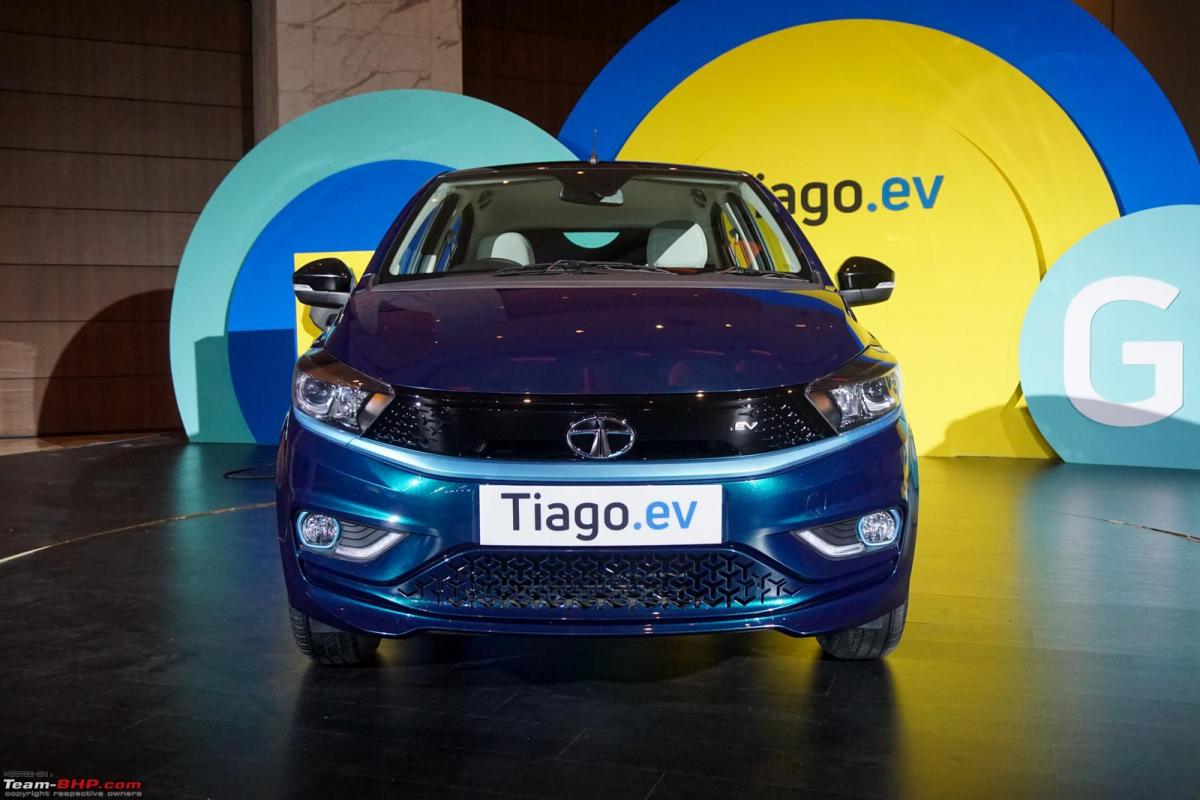
No design changes at the rear apart from the missing tailpipe:

The Tiago EV measures 3,769 mm in length, 1,677 mm in width and 1,536 mm in height and has a wheelbase of 2,400 mm. The EV is 4 mm longer than the regular Tiago:

Changes have been made to the suspension setup to integrate the battery and motor into the platform. While the exact ground clearance hasn't been revealed, it appears similar to the regular Tiago (170 mm):
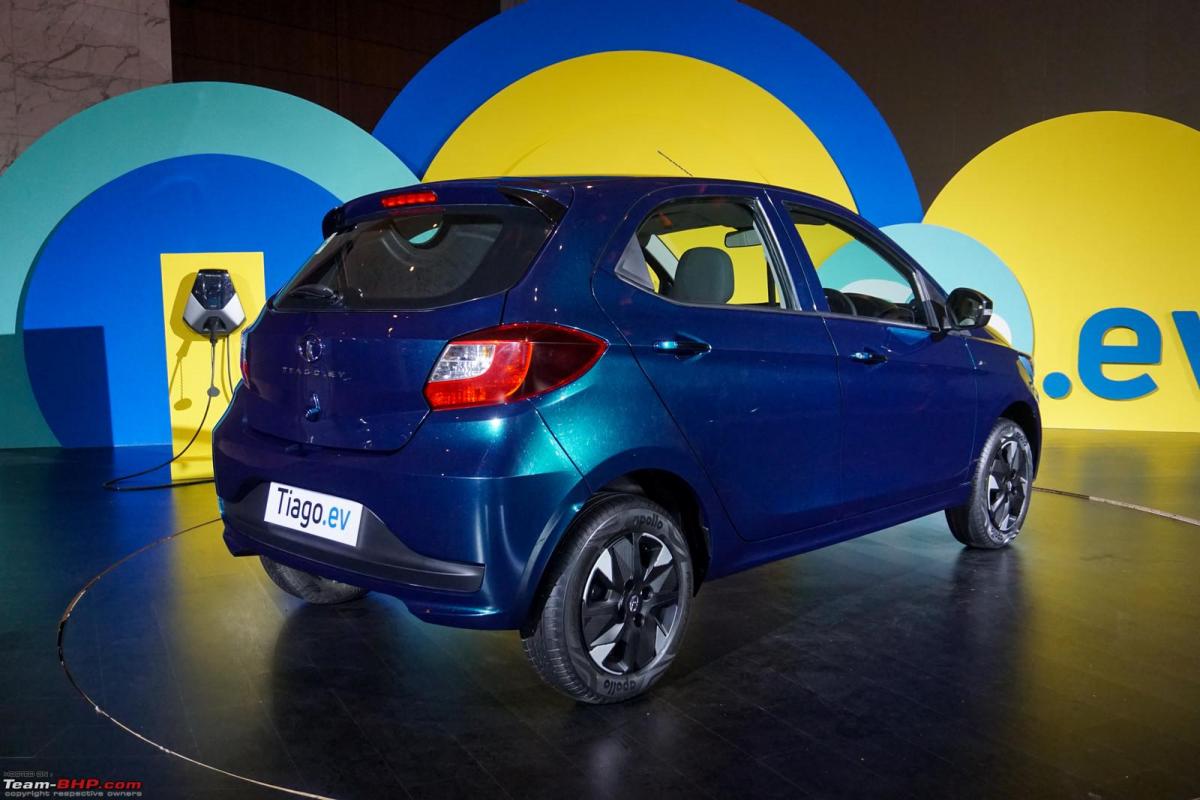
In profile, the 14-inch wheels look proportionate for the size of the car:

Halogen projector headlamps are offered on the XZ+ and XZ+ Tech Lux variants of the Long Range variant:
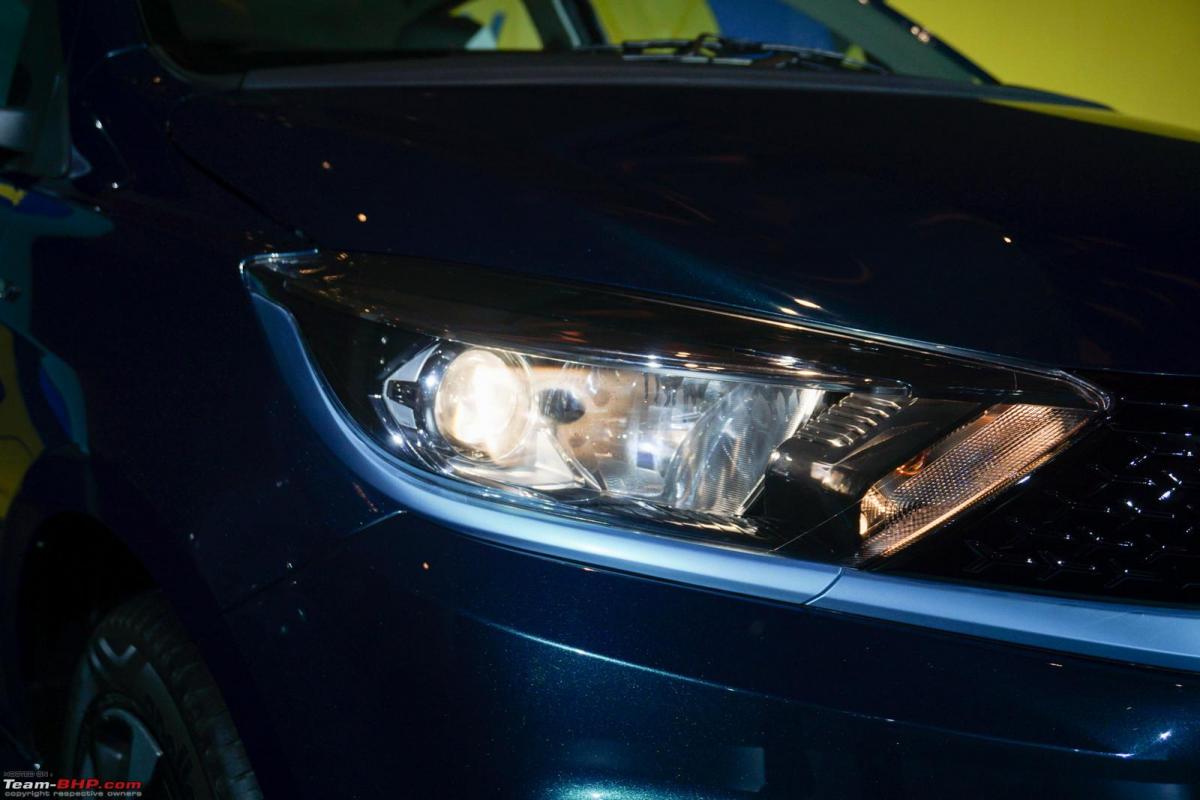
LED DRLs and foglamps are placed on the bumper. Fog lamps get blue accents around them:

The '.EV' badge on the grille doesn't feel like it will age well. The 'EV' badge on the Tigor looked better (reference image):

Sad to see that there's no underbody protection here. Being an EV, we would've expected Tata to make an exception and provide underbody protection, just for the additional peace of mind:

Another '.EV' badge on the fender. Check out the extra metallic shimmer of this 'Teal Blue' paint shade. The shimmer looks excessive under the spotlight, but should be normal under sunlight:

All door handles get nice piano black inserts:
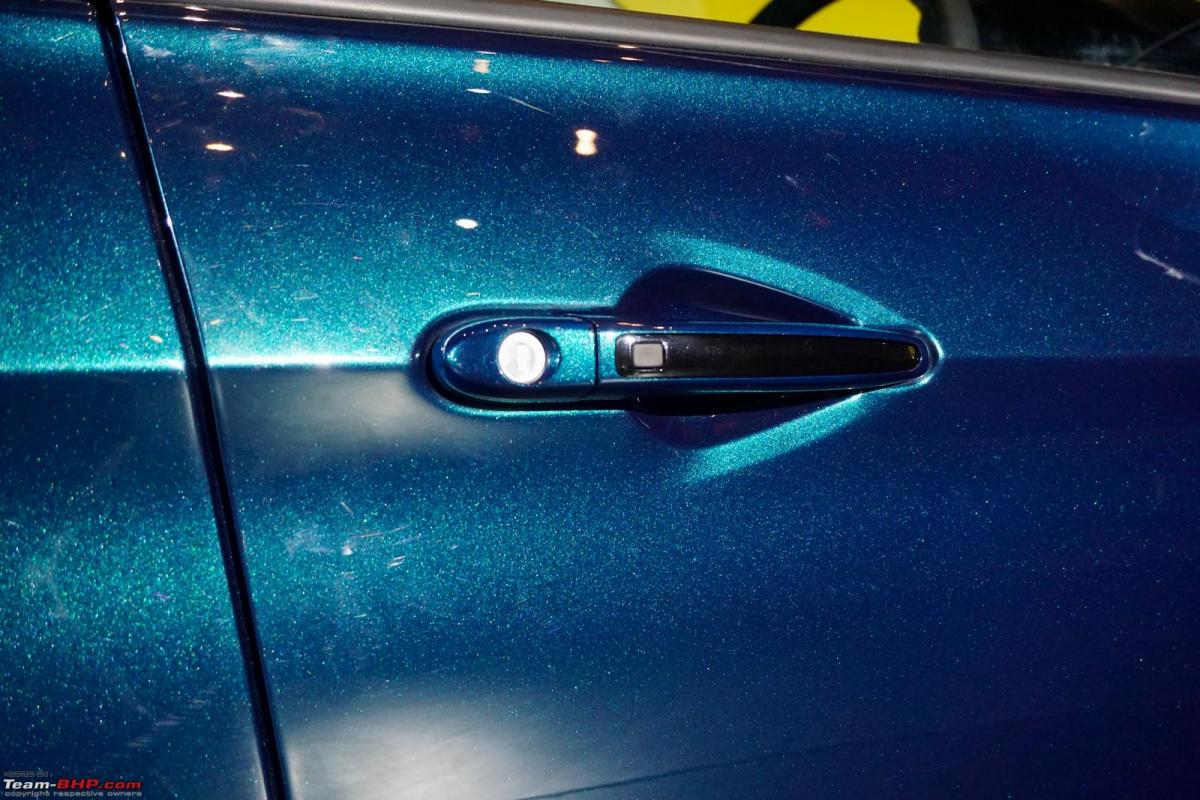
Roof-coloured ORVMs look good. These come with the auto-fold feature:

No 15-inch alloys here like the regular Tiago. Instead, you get these 14-inch steel wheels with 'Hyperstyle' wheel covers and 175/65 section tyres:

Drum brakes at the rear:

Tata needs to tighten up on quality control. The rear door handle was misaligned on the display car:

Contrast black roof is offered only on the top-end XZ+ Tech Lux variant:

Tail-lamp cluster is the same as the regular Tiago:

'TIAGO.EV' lettering has a different font compared to the regular Tiago. This one looks more classy. The placement of the reversing camera and boot release is just not ergonomic. You'll be brushing your hand against the camera while opening the hatch and the probability of it getting damaged in a collision is high:
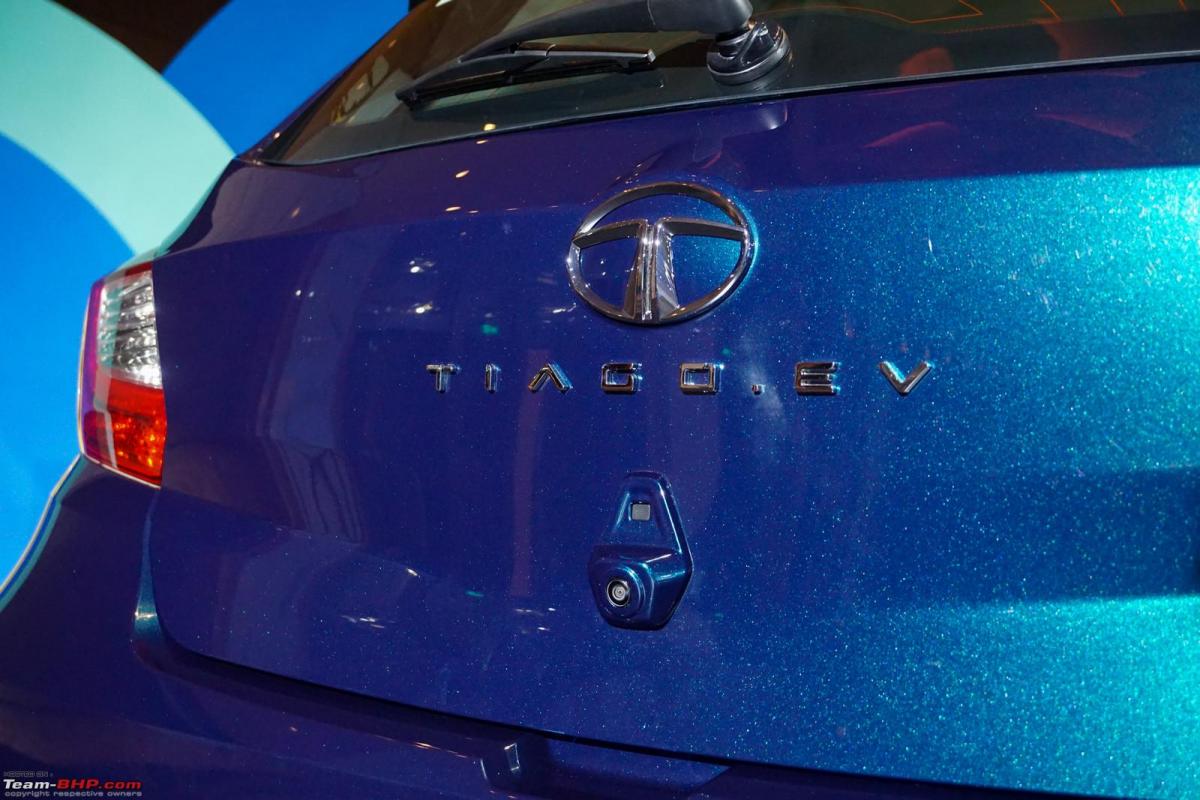
Look underneath and you will see the battery pack. The Tiago EV gets rear twist beam suspension with coil spring mounted on hydraulic shock absorbers:

High-voltage cables should've been covered up properly. Leaving them exposed is a bit disconcerting:

Permanent Magnet Synchronous Motor puts out 74 BHP & 114 Nm of torque. In comparison, the Tigor EV puts out 170 Nm of torque:

Cheap pipe leading to the washer fluid tank:

This 7.2 kW AC fast charger will charge the car from 10-100% in 3.6 hours. You can also save Rs. 50,000 and go for a 3.3 kW AC charger that will take 6.4 hours for charging from 10% to 100%. You always have the cheapest and the best option of charging from a 15A wall socket which takes 8.7 hours (10-100%). While on the road, you have the option of a DC fast charger which takes 57 minutes (50kW) to charge from 10-80%:

Battery pack gets the IP67 rating (water and dust-resistant). You also get 8 years / 1,60,000 km warranty for the battery and the motor. The standard warranty of the car is 3 years / 1,25,000 km. We suggest you definitely go for the maximum extended warranty option:
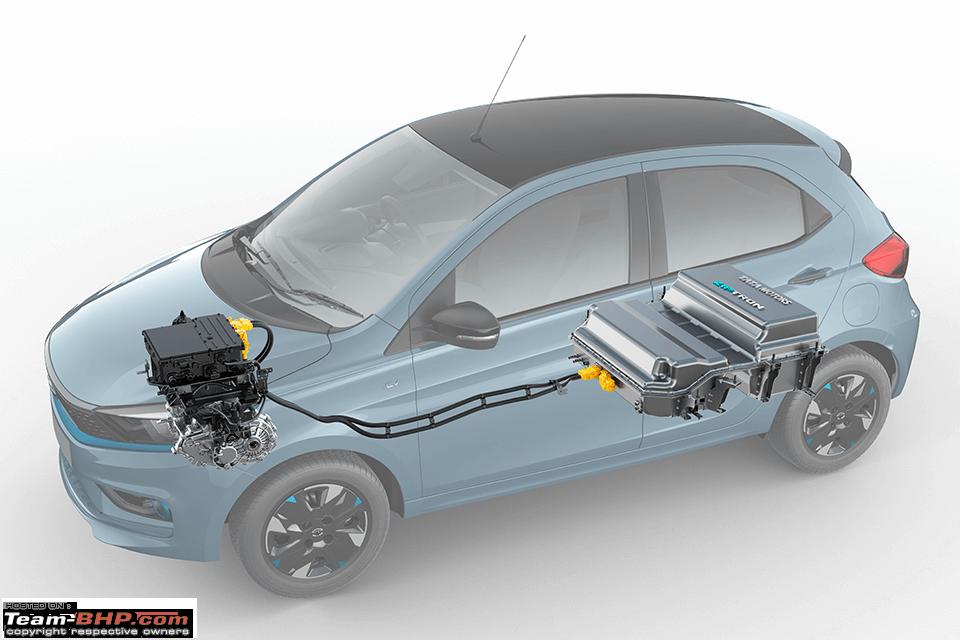
Here's the car in the 'Tropical Mist' paint shade...

...and the 'Midnight Plum' paint shade, which was introduced with the Tiago CNG:

Pages



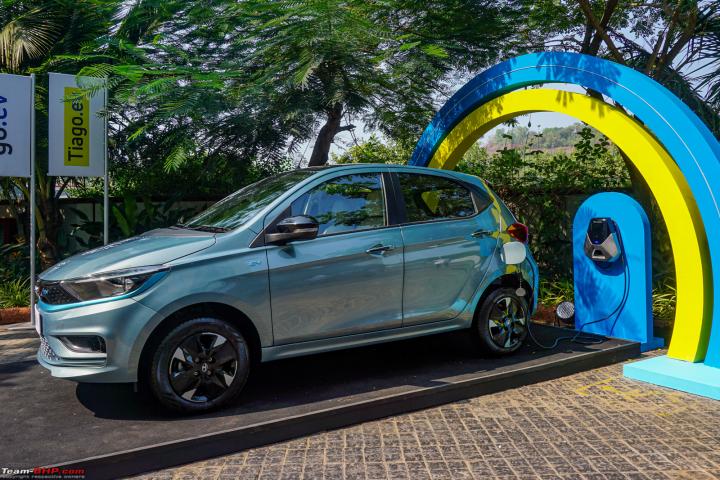








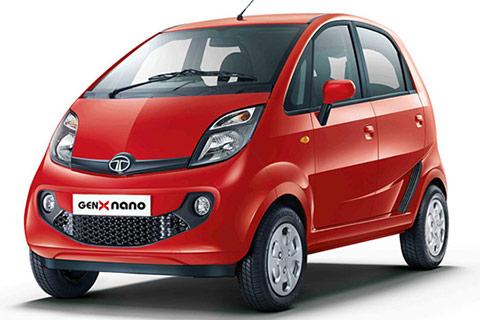





.jpg)
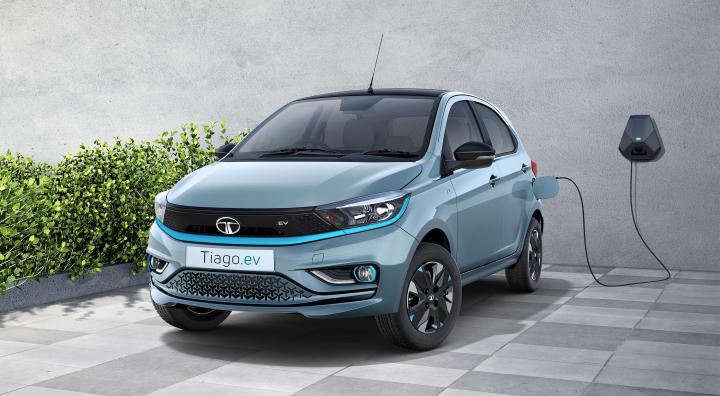



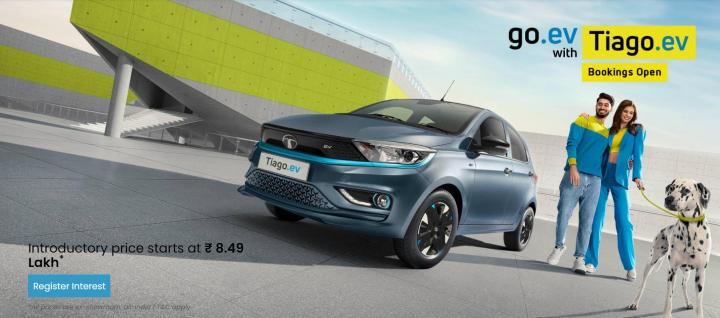
_3.jpg)
